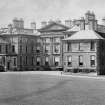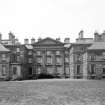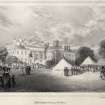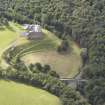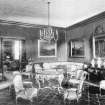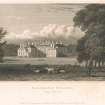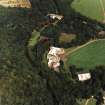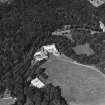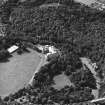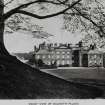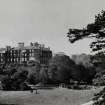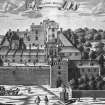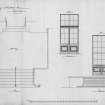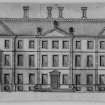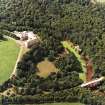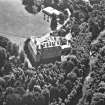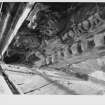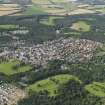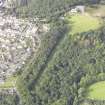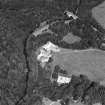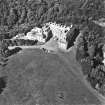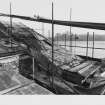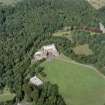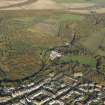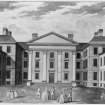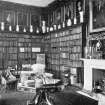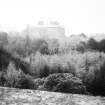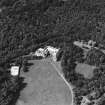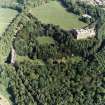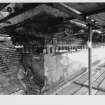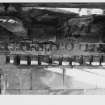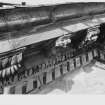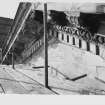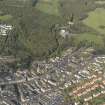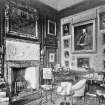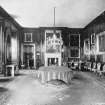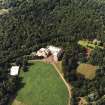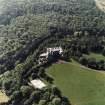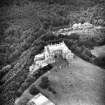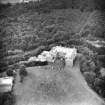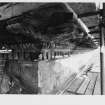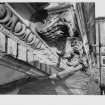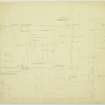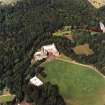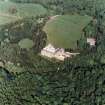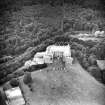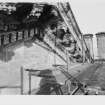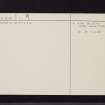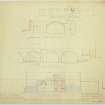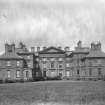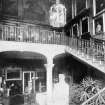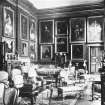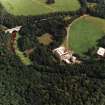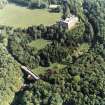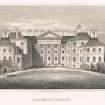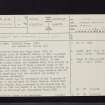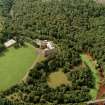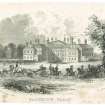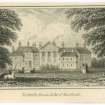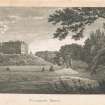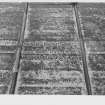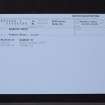Dalkeith House
Castle (Medieval), Country House (18th Century)
Site Name Dalkeith House
Classification Castle (Medieval), Country House (18th Century)
Alternative Name(s) Dalkeith Castle; Dalkeith Palace; Dalkeith Estate; Dalkeith Park; Dalkeith Country Park
Canmore ID 53504
Site Number NT36NW 7
NGR NT 33325 67905
Datum OSGB36 - NGR
Permalink http://canmore.org.uk/site/53504
- Council Midlothian
- Parish Dalkeith
- Former Region Lothian
- Former District Midlothian
- Former County Midlothian
NT36NW 7.00 33325 67905 Dalkeith House
NT36NW 7.01 3340 6786 Garden
NT36NW 7.02 3384 6766 Dark walk, gateway
NT36NW 7.03 33820 68251 Laundry Bridge
NT36NW 7.04 33740 68093 Stables and Coach House SW
NT36NW 7.05 33037 68437 Hermitage
NT36NW 7.06 33422 67706 Town gates
NT36NW 7.07 32192 67700 King's Gates
NT36NW 7.08 32208 67694 Gate lodge
NT36NW 7.09 32943 67778 Walled Gardens
NT36NW 7.10 33728 68101 Stables and Coach House SW
NT36NW 7.11 33731 68113 Stables and Coach House W
NT36NW 7.12 33742 68126 Stables and Coach House W (Courtyard Clock)
NT36NW 7.13 33749 68136 Stables and Coach House W
NT36NW 7.14 33764 68144 Stables and Coach House N
NT36NW 7.15 33771 68139 Stables and Coach House N
NT36NW 7.16 33779 68134 Stables and Coach House NE (Kennels)
NT36NW 7.17 33768 68108 Stables and Coach House E
NT36NW 7.18 33759 68095 Stables and Coach House E
NT36NW 7.19 33751 68085 Stables and Coach House SE
NT36NW 7.20 33748 68081 Stables and Coach House SE, adjoining Outbuilding
See also:
NT36NW 91 33767 68260 Laundry house
NT36NW 94 34055 68108 Gamekeeper's House
NT36NW 122 33353 67773 Ice house
NT36NW 87 33818 68175 Conservatory
NT36NW 65 3350 6850 Deer park
NT36NW 85 3357 6820 Steel park
NMRS REFERENCE
(NW 733 6789) Dalkeith House (NAT) and remains of Castle (NR)
OS 6" map (1968)
Dalkeith House was begun about 1700; it incorporates parts of Dalkeith Castle, a 15th century L-shaped keep with curtain walls which had been greatly enlarged about 1585. It now comprises a main block, two chambers deep, four storeys in height, from either end of which parallel wings of the same elevation, but unequal in breadth, project and end in pavilions, one storey lower. The S wing embodies the old tower so completely that the skeleton can hardly be distinguished internally.
The castle was the stronghold of the Douglases of Dalkeith; it was enlarged for James Douglas, Fourth Earl of Morton, Regent, then purchased by the Second Earl of Buccleugh in 1642 and ceased to be the principal seat of the Dukes of Buccleugh and Queensberry about 1885.
RCAHMS 1929, visited 1921; SDD List 1964
Dalkeith House is as described.
Visited by OS (BS) 30 October 1975
Photographed by the RCAHMS in 1978.
(Undated) information in NMRS.
From item in Archibald Craig Scrapbooks (4/57/4)
This is the residence of his Grace the Duke of Buccleugh, and stands about six miles from the city of Edinburgh, on the southern bank of the North Esk, and in the immediate neightbourhood of the town of Dalkeith. It is erected on the site of an old castle, which was for a long time the property of the family of Douglas. the Regent of Scotland, vix the Earl of Morton, frequently dwelt in this castle during the time that James VI. was a minor; which at that period commonly went by the ancestors of his Grace about the close of the 17th. century. It consists of a main body and two wings, having some ornaments in front of it of the Corinthian order. The principal staircase, and several rooms within, besides the great hall, are allowed by judges to be finished in a very elegant manner. In one set of rooms the furniture in use at that period is still preserved with great care, probably because it was the donation of Charles II. to his sone the Duke of Monmouth, and his daughter-in-law Anna Duchess and heiress of Buccleugh, who espoused the Dukle of Monmouth. There is an excellent collection of paintings in the palace of Dalkeith, executed by different artists who were eminent in their day. The river North Esk glide's along directly under the walls of the house, and over it an escellent bridge has been thrown at the expense of his Grace.
NMRS REFERERNCE:
Owner: Duke of Buccleuch
Architect:
James Smith 1701-1709
John Adam visits to inspect roof, sashes and other parts needing repairs, April 1762
Entrance lodge by James Playfair
Grinling Gibbons carvings
William Burn 1831 - additions
James Craig 1776 - adds not executed
Robert Adam 1794 - design for entrance gates and lodge
NMRS Printroom
W Schomberg Scott Photograph Collection Acc no 1997/39
detail of stonework on the entrance front - 2 prints
EXTERNAL REFERENCE:
Royal Botanic Gardens Library - The Book of the Garden by Charles Mackintosh - text
Scottish National Portrait Gallery - Country Life October 7th, 1911 & September &th 1935 - article and photographs
SCOTTISH RECORD OFFICE:
RHP 9520 (1718) and 9521 (1759) - plans of park (including Smeaton)
RHP 9536 1824 - plan of park
RHP 9539/9541 1831 -plan of park
RHP 9687/9 9697/9706 19thc - plam of house and stables
RHP 9715/12-13 19th C - plans of layout of garden
Accout for work done at ? Dalkeith Castle.
ND GD 150/2740
Repairs and additions to be made to Dalkeith Castle. Estimate for #2000. A note is added there must be a clause obliging Mr Smith to heighten the walls of the old house at the same rate he builds the new.
1702 GD 26/5/492
Repair of Dalkeith Castle. Articles of agreement.
1709 GD 26/5/489
Letters by William Burn, architect, 131 George Street, on buildings and improvements on Buccleuch estates.
1830-38 GD 224/508/1
Accounts and legal papers relating to claim by John Adam, architect, as representing his late father, William Adam, architect, against the representatives of the late Francis, [2nd] Duke of Buccleuch, for payment for building a bridge, stables and other offices at Dalkeith "and for other works perfomed there". The bundle includes (with an inventory) 18 estimates, accounts, and letters by the 2nd Duke to William Adam, on all of which the claim was bases. Some of the letters are endorsed with brief comments apparently in William Adam's hand, though not signed or initialled. The bundle also includes a letter by John Adam to Archibald Campbell, W.S., dated 6 September, 1757, regarding the clain (no.21).
1740-58 GD 224/337/4
Account book of workmen employed about the palace of Dalkeith, June - Dec., 1724.
(Includes names of workmen)
Copy account rendered to the Duke of Buccleuch by John Adam, architect, for work done at Dalkeith House, etc.
1724 GD224/84/9/9
Contract tradesmen's accounts and legal papers relating to the addition made to Dalkeith House by Anna, Duchess of Buccleuch, and to subsequent Court of Session process arising from her allegations of faulty workmanship on completion of the work. (31 items)
They include:
(1) 1702, March 21. Extract of contract between Anna, Duchess of Buccleuch, on the one part, and Mr James Smith of Whythill, and James and Gilbert Smith, masons in Edinburgh, on the other part, whereby the latter parties undertake to build in good and sufficient mason work the addition designed tobe made to the Castle of Dalkeith.
[Registered in the Books of Council and Session on 3 October, 1711]
(30) 1717, January 16. Interlocutor finding in favour of James Smith
1702-1717 GD 224/391/1
Letter (no.1) by John Adam, architect, Edinburgh, 17 February 1762, to John Craigie of Kilgraston, advocate, enclosing account (no. 2) of work done by him for the Duke of Buccleuch at Dalkeith between 1752 and 1757, and not yet paid for; and relative letters (n s. 3-16) by Gilbert Grierson, chamberlain of Dalkeith, and Donald Dunbar, W.S., to Mr Adam between 1752 and 1754, authorising or relating to the various pieces of work referred to in the account. Subjects include inter alis survey and estimates for repairs to Dalkeith church and manse; nomination of a skilful person to survey for coal at Hawick; inspection of repair work to Dalkeith mills; plumber work on roof of Dalkeith Palace and pavilions.
(16 items)
1752-62 GD 224/388/1B
Debts of Francis, [2nd] Duke of Buccleuch: scrolls or drafts of assignations and discharges by some of the Duke's creditors. No. 2 (containing 4 items) relates to sums owed to John Adam, architect, Edinburgh, representing his late father, William Adam, architect. (Numbered 1-19: a total of 22 items)
GD 224/379/7
1752, April 7. Copy report on, and estimate of repairs to, the roof and chimney heads and some other parts of Dalkeith House, by John and Robert Adam, architects.
GD 224/379/1/49
Miscellaneous Dalkeith vouchers. (High Somervell, W.S., Receiver General). (Includes discharge by Wm Adam, architect, 1727 (for drawing up plans)).
1727-9 GD 224/259A/2
The castle was sold by the Earl of Morton to Francis 2nd Earl of Buccleuch in 1640. It was remodelled for Anne, Duchess of Buccleuch 1702-1710 by James Smith (c.1645-1731) who demolished part of the existing castle and incorporated the rest into the new house.
Account for repair work at Dalkeith Castle (house).
N.D. (pre 1642) GD150/2740 (Morton)
Copy of drawing attributed to John Elphinstone c.1740s in poss. of Mrs N Cooper, London - 1 photograph
Field Visit (11 May 1921)
Dalkeith House.
Dalkeith House or Palace (Fig. 91 [SC 1234089]) stands on the high right bank of the North Esk, some 200 yards below and north of the town. Although it appears homogeneous and has an orderly and symmetrical lay-out, examination of the fabric and plan proves that a much earlier building has been retained in an early 18th-century reconstruction. Additional evidence of this is furnished in the interesting 17th-century drawing, preserved in the business room at Dalkeith and reproduced in Fig. 92 [SC 1234099], wherein the castle of the time is evidently very faithfully represented.
The growth of the building can be set down as follows. The nucleus is a tower of about 15th- century date, L-shaped on plan, which is incorporated in the present south wing. Part of the original ashlar masonry of this tower is seen from the roof of the modern kitchen extension, in the 10-foot wide stretch of red freestone, occurring at the level of the present first and upper floors, built in courses 9 to 15 inches in height; in this stretch can be traced two windows which have been built up. They are about 12 inches wide and 3 ½ feet high and have the chamfer of the period on jamb and lintel. To the north of the tower lay a trapezoidal barmkin enclosed by curtains furnished with crenellated parapets. This was entered, probably over a ditch, through a gatehouse placed towards the middle of the north wall. The curtain had a heavy projecting base-course, and a small portion of this remains within the basement, on the north. In the 16th century and later the curtains were partly rebuilt-the south-west angle shows 16th-century quoining-and incorporated in structures, one chamber deep, which were reared against them, while a wing was built on the north, parallel to and outside the north curtain, and was provided with a second gatehouse penetrated by an arched pend. The north wall retains in situ at ground level, between the modem oriel and forestair, a 16th-centurywindow, and, at first and upper floor levels, the jambs of other windows of the same time wrought with a quirked edge-roll.
In the 18th-century rebuilding the former floor levels seem to have been retained and the old walls to have served anew, but the east side of the enclosure was demolished, together with part of the return structures; the buildings thereby exposed within were given a new front, one chamber deep. The old tower was gutted, its parapet and roof were removed, and its walls. skinned and squared up to fit in with the new project; in the other structures new and more adequate windows were inserted, and probably another storey was added. When the east side of the enclosure was demolished, a considerable quantity of building material became available for use elsewhere, and in the walls of the new front there can be seen old ashlar and moulded dressings rebuilt as rubble; as the greater part of the wall surface was originally harled, these re-used dressings would not, of course, be noticeable.
[see RCAHMS 1929 pp.61-65 for a detailed architectural description]
RCAHMS 1929, visited 11 May 1921.
(On the Dalkeith families, see Introd. p.xxxviii)
Photographic Survey (1953)
Photographic survey by the National Buildings Record Scottish Council in 1953.
Publication Account (1998)
In quite different character, but also built in the eighteenth century, is Dalkeith House figure 23.A. Although not technically within the burgh, the presence of the castle, later converted into a palace, and its occupants and visitors had a profound effect on the town and its life (passim). The first fortified building here was possibly constructed in the twelfth century. Documentary references to great depths of top soil suggest that this earliest castle was of motte and bailey type, and would have comprised an earthen, flat-topped mound, topped by a wooden tower. A palisade around the top edge of the mound provided extra defence. An outer, defensive ditch would have surrounded the base of the mound, the upcast from which formed the fabric of the motte itsel( Mottes often have an outer enclosure, or bailey. This contained many of the domestic buildings and structures, and it was only during an attack that the tower on the motte itself was occupied. If a motte existed here, then it may later have been converted to a stone castle, by the replacement of existing timber defences in stone. Within a stone curtain wall, a range of buildings, probably of timber, would have stood around an open central courtyard. It would be natural that a readily defensible spot would attract settlers to cluster near it for protection. The castle would also need supplies and manpower and this, in turn, would have attracted nearby settlement. It is, therefore, highly probable that the site of the earliest settlement lies in the present estate of Dalkeith.
The owners of Dalkeith Castle figure 6, the Douglas family, who from 145 7 were the earls of Morton, were of sufficient importance on the political scene that the township was to participate in many national events, some welcome and others disastrous for the peace of the settlement. There is evidence, for example, that Dalkeith was sacked and burned on many occasions in the medieval period and in the sixteenth century (see pp 21 & 23). The castle, however, was of' sufficient grandeur by this time that it was oflcn host to royalty. The presence of' nobility and royal retinue would not only have been a common sight in the town, but would also have provided employment and a market for supplies.
In the 1570s James Douglas, fourth earl of Morton, converted the castle into a Scottish Renaissance palace, known locally as the ' Lion's Den', so feared was he figure 8. In 1642, it was sold to the earls of Buccleuch; and from 1654 to 1659 it was the residence of General Monck. Anne, duchess of Bucclcuch, returned from England sometime around 1701 and immediately set about upgrading the family home. James Smith was commissioned to design and effect the alterations. This new eighteenth-century palace incorporated a number of the features of Morton's original. The south-eastern courtyard wall was demolished, parts of the earlier building were absorbed, particularly in the south-western corner and probably also in the north and west wings. This U-plan mansion had one of the earliest classical facades in Scotland. The lavishness of' the interior and the trappings that accompanied it were of equal grandeur. Repair and refacing by John Adam took place in 1762-3; and it is possible that some of the detailed richness comes from this time. Later in the century, in the 1780s, a few alterations were effected, including the addition of a bow fronted library in the cast range, by William Playfair. Further modifications were effected in 1831 by William Burn, although most of his original design was not adopted.
Dalkeith House, as it stands today, is the product of' centuries of building, alterations and refurbishments, all of which survive in some form or another. Structural elements of all of the earlier phases may be contained, or even incorporated, within the fabric of the present building or lie scaled below the present floor levels. As the later conversion of the palace to country house absorbed much of' the existing standing building, the very earliest phases may be the most archaeologically testing. At its core is an early castle, dating very probably to the twelfth century. The conversion of the palace to country house involved the demolition of the south-cast courtyard wall. This is likely to have had fairly substantial foundations and should survive below present ground level.
Information from ‘Historic Dalkeith: The Archaeological Implications of Development’ (1998).



















































































